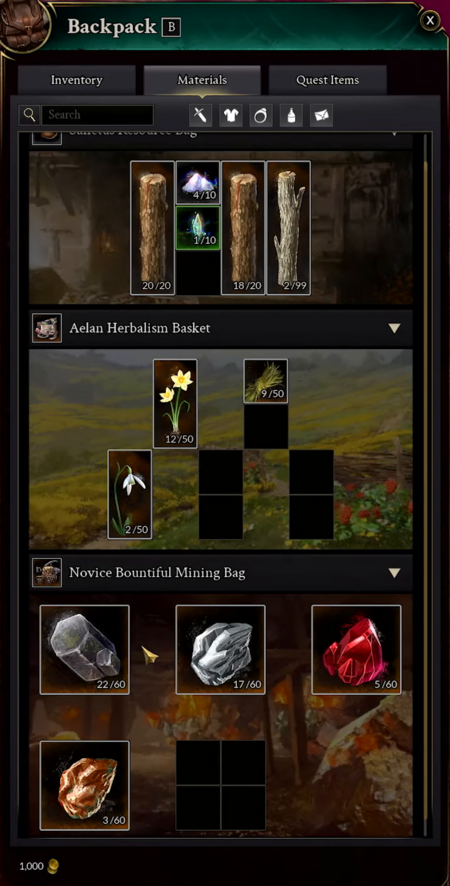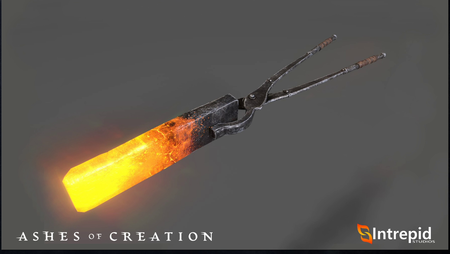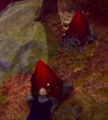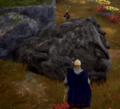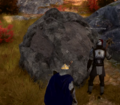Gatherable resources
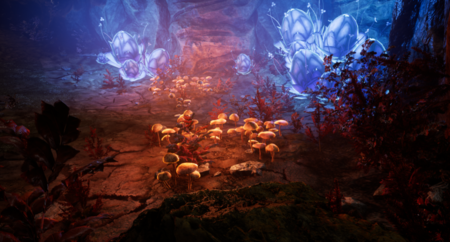
We want our players to have a reason to explore the wilderness, to travel with purpose, and much of that will be driven by our resource system. Transporting these goods might just be more difficult than gathering them. Our regional market system allows players to participate in creating pocket economies that will reinforce the stability of goods in particular regions.[2]
Gatherable resources (also known as raw materials, gatherables, and harvestables) occur in locations where you would expect them to be organically.[3][4]
- Lower level resources will be abundant. Higher level resources that are gatherable by Apprentice level or higher artisans will spawn randomly but in places that make sense for that type of resource. Surveying is a mechanic that solo or group players can utilize to track these resources down.[3]
- We want to be able to spawn stuff randomly and we want to put it in places in the world that will make people travel and bolster up our local player-to-player economies: have people actually be out in the world looking for stuff and not standing in the same place waiting for a tree or a flower to respawn over and over again. So, we're having the best of the both Worlds where we have our lower tier stuff that will fill out the base look of our world, so that it's always looking good; and then the higher tier stuff, from apprentice onward, will always spawn randomly in places that we've deemed look good and make sense for what that thing is. So, surveying is a way that you can track that stuff down. It will help you find places, will help you find particular resources, will help you find resources at a certain rarity; and so it should be something you could do as a gatherer on your own, or group up with other people to bolster up the power of your survey, or the range or reach of it.[3] – Kory Rice
- Certain resources will only be gatherable for a limited time during specific story arcs.[5]
- You want to take advantage of the limited time you have during the story arcs to get some of these rare resources for crafting things.[5] – Jeremy Gess
- Some resources are only gatherable at specific times of the day or night.[10]
- The location the resource was found can affect the benefits, bonuses, and other characteristics of that resource.[11]
- Players drop resources and other items upon death, based on their applicable death penalties.[14][15][16][17]
- Resources looted from caravan wreckages become stolen resources.[18][19]
- Resources do not expire or degrade over time.[20]
- We don't want to create an environment I feel where you're having to micromanage each of the resources that are very vast in our game. We have 100 plus material system where you're having to play whack-a-mole with managing those things... I don't see the value in it.[20] – Steven Sharif
- Raw materials (gatherable resources) are not to be confused with crafting materials (processed goods).[21][22]
List of gatherable resources
Seasonal resources
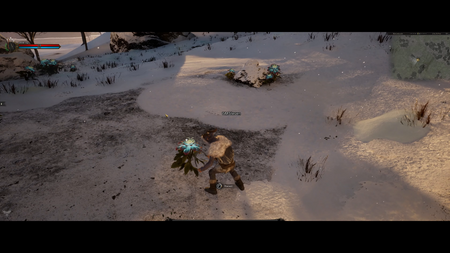
If a particular region moves into a season and that week you can't grow a particular type of good, but another region halfway across the world can grow that good; and you talk about moving those goods across regions so that they're relevant to either craft workbenches or you can sell them in the local economies: That is a major indicator of movement of goods and movement of goods carries risks; and risks can create political foes and friends... Something as simple as just a climate can have cascading consequences across the entirety of the game.[24] – Steven Sharif
Seasons affect crops and other herbology resources available for gathering or planting, including how crop rotation is managed.[6][7][8][9]
- Seasonal variations in resource availability will impact the economy and necessitate the transit of goods between different regions.[7]
- One of the things that is huge about the season system and how it affects crops and the gatherables in the game is the impact it will have on the economy. When a particular area no longer is capable for a week's period of time, or even potentially longer, of producing a certain type of crop or harvestable; and that has to change across the world regionally, now the transit system of those materials of those gatherables they become more relevant, and they're subject to potential risk; and the prices might go up in certain areas. It is something that is actually very instrumental in the overall design of the economy in the game.[7] – Steven Sharif
- Seasons may not directly affect certain gatherables, such as veins of ore, but access to those resources may be blocked during certain weather conditions.[6][7]
- It won't likely affect too much on certain resource spectrums like veins of ore. Those might not be affected by the seasons or weather systems, but there might be blockages to cave networks that house those types of ore veins. Alternatively it is going to be significant impact on any type of herbology or plant-based types of gatherables. It's going to have significant impacts on crops that players can plant themselves on their properties; and that they'll be able to harvest. They're going to need to time the crop placement and its maturity window so that it's harvestable and available to be harvest before the change of seasons that might adversely affect certain types of crops. And not every biome will experience the same type of effects caused by the seasonality of the world. The desert biome might instead of snow have significant more winds that pick up that could be damaging to more fragile types of crops if you have a freehold in that location.[6] – Steven Sharif
Resource quality
Recursos will have differing tiers of quality for the same resource type.[13] This is somewhat similar to Star Wars Galaxies.[26]
- Gatherers who are more advanced in their artisan tree will unlock higher level harvesting tools that have a greater chance of collecting higher quality resources or proccing a greater quantity.[13][27][28]
- You will have an opportunity to proc certain qualities based on your progression in the Artisan tree. So if you are a gatherer; and as you advance in your gathering, you'll have a higher opportunity to collect better resources.[28] – Steven Sharif
Item rarities
Item rarities in Ashes of Creation.
- Poor.[29]
- Common.[30][31]
- Uncommon.[30][32]
- Rare.[30][33]
- Heroic.[30][34]
- Epic.[30][35]
- Lendários.[30][36]
- Artifact.[30]
Resource locations
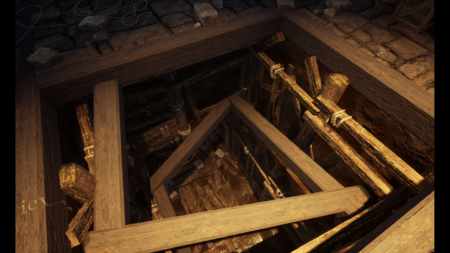
Players will be able to move resources and set up shop in other areas to take advantage of the varied markets. With resources spawning dynamically, certain regions will naturally become important trading hubs for the transportation of goods throughout the world.[2]
The location a resource is found can affect its benefits, bonuses, and other characteristics of that resource.[11]
- Lower level resources will be abundant. Higher level resources that are gatherable by Apprentice level or higher artisans will spawn randomly but in places that make sense for that type of resource. Surveying is a mechanic that solo or group players can utilize to track these resources down.[3][12][13]
- Some resources will exist as a cluster (also called vein gatherables). These will last until the full resource is depleted.[38][12][13][4][39]
- Like a large mine that's present and has a vein of mithril ore in it, or a herd of some type of animal that you can collect fur or wool from.[13] – Steven Sharif
- Once a vein resource is depleted from one location it may respawn in the same location or somewhere else, depending on the type of resource.[13][4][40]
- There will be moving resources such as herds of animals that are constantly moving around the world.[38][40]
- Herds are a source of certain types of wild gatherables but they're in animal form and they're animated; and they exist in a group of the golden fleece sheep that might only spawn very rarely in certain hillsides; and only during spring. And if you can find that vein so to speak of resource you can interact with the herd and you can gather from them.[38] – Steven Sharif
- Corrupted areas house corrupted resources that are necessary components for certain crafting recipes.[41][5]
- Certain types of resources will have a corrupt state... We have a Spirit Bloom, which is a harvestable herbalism plant, but when a Zone becomes corrupt you can potentially yield Corrupted Spirit Blooms; and those are necessary components of certain crafting recipes.[41] – Steven Sharif
- Resources respawn on a cooldown basis.[4]
- Resources won't be locked to the node system.[4]
- Starting resource points may be different on each server.[43][44]
Surveying
Surveying plays a key role in helping gatherers track down and identify resources that spawn in particular locations through the use of surveying tools.[3][45][46]
- Surveying is something that we're trying to use for gatherers to really interact with the things that we want to do with our dynamic world... Surveying is a way that you can track that stuff down. It will help you find places, will help you find particular resources, will help you find resources at a certain rarity; and so it should be something you could do as a gatherer on your own, or group up with other people to bolster up the power of your survey, or the range or reach of it.[3] – Kory Rice
- Surveying can also identify the types of resources that spawn statically within an area and also provides information about the seasons and locations they spawn in.[45]
- Surveying is a way that players can check out an area for resources. Players can learn where resources are that are static and that grow back in the same location; but we'll also have resources and Ashes that can spawn anywhere, so surveying will help players locate those those resources. So if they're looking for something specific they can hunt them down. Surveying will also allow players to uncover hidden resources that players wouldn't be able to see with their with their naked eye. Another thing that a surveying would provide is some of the information that we're talking about before, like for instance if you survey- and inside of your survey area there's plants, you might learn what season that plant likes to grow in. You might learn whether it likes to be watered during the winter versus how it likes to be watered in the summer.[45] – Kory Rice
- Surveying can help uncover hidden resources that are not visible to the naked eye.[45]
- Artisan progression unlocks higher level surveying tools that enable better identification of gatherable resources within a location.[45]
- Unlocking surveying pylons allows the gatherer to adjust the shape and extend the area of their survey.[45]
- You'd work with a surveying tool; and you set the surveying tool down, and that tool would have a specific area in which it's able to uncover and extract information about the resources that are in the area. As a starting out gatherer you might end up with one of the tools, but as you as you progress and become more proficient with using the tool you might be able to set up additional pylons and extend the area of your survey. That allows you to start making shapes and having more strategic areas that you're surveying. If you could connect multiple pylons to create a shape, maybe you could follow the twisting caverns of the cave. Maybe if you're out in the open like we are here you could just try and make yourself a nice widened shape to scan as much of the area as possible. So it'll be up to the player to be tricky with their surveying tool to try and get the most efficiency out of their survey.[45] – Kory Rice
Land management
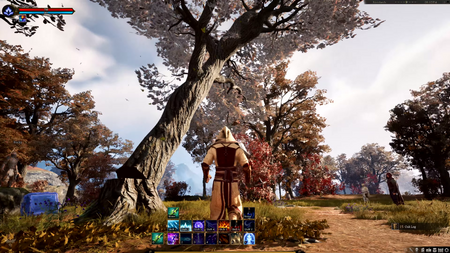
As you draw resources from your surrounding area- what type of effect does that have on the land; and then also how effectively can you draw those resources without having such a deleterious effect on the land, which might impact future resource gathering for some period of time: And it makes relevant the movement of these players who are collecting these goods from the environment, that they actually cannot always just do so in one particular area, as the land management begins to degrade. So it actually encourages movement across the world to discover new areas that might not be as perturbed as the ones you're coming from. It's a very interesting idea. It's something that we're going to be prototyping in Alpha 2 and getting feedback on and testing.[46] – Steven Sharif
Land management mechanics are present for gathering artisans.[48][46]
- The spawn rate of resources in a given area is influenced by how players are interacting with those resources.[48][46]
- Drawing excessive amounts of resources may have a deleterious effect on the land health value for that area.[48][46]
- Actions like ridding an area of invasive species or performing crop rotations on freehold farms may have a positive effect on that area's land health value.[48]
- Defeating certain world bosses or mobs can positively impact the respawn rates of resources and animals in their vicinity.[49]
- It could be could be positive or negative, or both simultaneously. So the land health value ties into the health of a specific ecosystem; and the ecosystem can scale with different segment sizes of the world, or the world itself: A biome, maybe a node, maybe the player's freehold. And the things that a player does in those areas will contribute to health in a positive or negative way. So doing something like rotating your crops might increase the health of the land because that's considered something good to do; and maybe apprehending or removing poachers that are over hunting a certain species could be helpful to the health of the land. Maybe the mayor puts out a request for players to try and get rid of invasive species that are plants- maybe they're overgrowing weed and it's stopping other valuable plants from growing.[48] – Kory Rice
- The spatial inventory system is intended to mitigate the potential for players to diminish land management scores by stripping resources from particular zones.[50]
- There's a particular reason for why that inventory system is intended to exist within Ashes; and part of that is from the aspect of everything in the world is gatherable and there is a land management system that exists behind those gatherable things. The land management system takes into account how players are interacting with the environment: how many of the resources they're withdrawing from the world; and that decreases the spawn rate within certain localities as those things go too high. So there can be a degree of economic warfare by sending players out into zones where you want to mitigate collection of resources. You send your players out there to take all those resources and then that diminishes the land management score of that particular zone.[50] – Steven Sharif
Recursos subterrâneos
Recursos serão diferentes no subterrâneo.[51]
- Isso afetará as profissões de Plantação e Criação de animais.
- Já que os jogadores só poderão ter uma propriedade, eles devem escolher sua especialização de classe artesã de acordo com se querem possuir terras no subterrâneo ou na superfície.
Gathering tools
Classes artesãs de coleta requerem a criação e o uso de ferramentas de coleta que permitem a coleta de recursos.[53][54]
- Progressão na classe artesã da coleta abre ferramentas de coleta de nível mais alto que permitem a coleta de recursos de nível mais alto.[27]
- Um coletor com proficiência máxima abrirá Master toolsets, o que lhe concederá acesso aos coletáveis da mais alta qualidade.[12]
- Ferramentas terão durabilidade e vida útil.[12][55]
- Artesãos não precisarão depender de outras árvores para fazer suas ferramentas.[53]
As ferramentas avançam na árvore de artesanato, então a sua capacidade de coletar, processar ou fabricar vai precisar das ferramentas equivalentes necessárias naquele estágio de criação para realizar a sua tarefa. Então você não poderia minar cobre e mithril com a mesma ferramenta.[54] – Steven Sharif
O processamento requere blueprints para a construção de edificações que são necessárias para processar recursos.[53]
- A fabricação requere a aquisição de receitas para fabricar itens.[53]
Gathering tool tiers
Gathering tools for Mineração, Herbalismo, Lenharia, and Pesca are associated with a resource tier.[56][57] For example: A tier 2 axe can gather tier 1 and 2 lumber and no higher.[58]
| Tool rarity | Resource tiers | Vendor price | Vendor location |
|---|---|---|---|
| Common | 1 | 10g | Alpha-1 starting area |
| Uncommon | 1 - 2 | 100g |
[[{{{2}}}]] (estágio 1) nodes |
| Rare | 1 - 3 | 500g |
[[{{{2}}}]] (estágio 2) nodes |
| Epic | 1 - 4 | 2000g |
[[{{{2}}}]] (estágio 3) nodes |
List of gathering tools
| Item | Icon | Type | Resource tiers | Rarity | Level requirement | Source | Cost |
|---|---|---|---|---|---|---|---|
| Apprentice Herbalism Sickle | Tool | Common | Apprentice | Crafted items | |||
| Apprentice Lumberjacking Axe | Tool | Common | Apprentice | Crafted items | |||
| Axe | Tool | 1 | Common | 1 | Vendor | 10 | |
| Beginners Pole | Fishing pole | 1 | Common | 1 | Vendor | 10 | |
| Copper Pickaxe | Pickaxe | 1 | Common | 1 | Vendor | 10 | |
| Crude Herbalism Sickle | Tool | Common | Crafted items | ||||
| Cultivator | Tool | 1 - 3 | Rare | 1 | Vendor | 500 | |
| Diamond Tipped Pickaxe | Pickaxe | 1 - 4 | Epic | 1 | Vendor | 2,000 | |
| Intermediate Pole | Fishing pole | 1 - 2 | Uncommon | 1 | Vendor | 100 | |
| Iron Chopper | Tool | 1 - 2 | Uncommon | 1 | Vendor | 100 | |
| Iron Pickaxe | Pickaxe | 1 - 2 | Uncommon | 1 | Vendor | 100 | |
| Journeyman Lumberjacking Axe | Tool | Common | Journeyman | Crafted items | |||
| Master Lumberjacking Axe | Tool | Common | Master | Crafted items | |||
| Novice Herbalism Sickle | Tool | Common | Novice | Crafted items | |||
| Novice Lumberjacking Axe | Tool | Common | Novice | Crafted items | |||
| Novice Mining Axe | Tool | Common | Novice | Crafted items | |||
| Shears | Tool | ||||||
| Soil Knife | Tool | 1 | Common | 1 | Vendor | 10 | |
| Steel Pickaxe | Pickaxe | 1 - 3 | Rare | 1 | Vendor | 500 | |
| Tiller | 
|
Tool | 1 - 2 | Uncommon | 1 | Vendor, Quest rewards | 100 |
Resource extractors
Resource extractors are potential constructions that can collect resources over time.[59][60]
- Available to node citizens who own a freehold near a "resource center".[60]
- Requires several people to construct.[60]
- Moving resources from the extractor will likely require a caravan.[60]
Timeline
Classes Artesãs estão programadas para lançar no Alpha-1.[61]
Visuais
2023-07-01
Ver também
Referências
- ↑ Transmissão ao vivo, 2017-09-03 (10:48).
- ↑ 2.0 2.1 About Ashes of Creation.
- ↑ 3.0 3.1 3.2 3.3 3.4 3.5 Vídeo, 2023-11-30 (28:22).
- ↑ 4.0 4.1 4.2 4.3 4.4 4.5 Transmissão ao vivo, 2017-05-08 (54:26).
- ↑ 5.0 5.1 5.2 Vídeo, 2023-03-31 (16:42).
- ↑ 6.0 6.1 6.2 6.3 Transmissão ao vivo, 2022-05-27 (55:47).
- ↑ 7.0 7.1 7.2 7.3 7.4 Vídeo, 2022-05-27 (15:50).
- ↑ 8.0 8.1 Transmissão ao vivo, 2017-05-08 (20:27).
- ↑ 9.0 9.1
- ↑ Vídeo, 2023-11-30 (34:36).
- ↑ 11.0 11.1 Transmissão ao vivo, 2023-04-28 (1:24:36).
- ↑ 12.0 12.1 12.2 12.3 12.4 12.5 Transmissão ao vivo, 2020-07-31 (1:05:58).
- ↑ 13.0 13.1 13.2 13.3 13.4 13.5 13.6 Transmissão ao vivo, 2020-07-25 (1:04:50).
- ↑ Transmissão ao vivo, 2021-03-26 (1:07:33).
- ↑

- ↑ Podcast, 2017-05-05 (43:05).
- ↑ Entrevista, 2020-07-18 (27:11).
- ↑ Transmissão ao vivo, 2023-10-31 (1:18:33).
- ↑

- ↑ 20.0 20.1 Transmissão ao vivo, 2023-03-31 (1:19:26).
- ↑ Transmissão ao vivo, 2017-05-05 (34:15).
- ↑ Transmissão ao vivo, 2017-05-10 (8:22).
- ↑ Vídeo, 2022-10-28 (19:10).
- ↑ Transmissão ao vivo, 2022-04-29 (56:24).
- ↑ Vídeo, 2023-11-30 (30:19).
- ↑
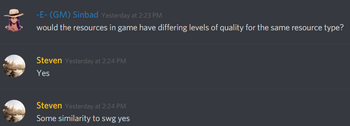
- ↑ 27.0 27.1 Transmissão ao vivo, 2020-04-30 (53:11).
- ↑ 28.0 28.1 Entrevista, 2018-10-20 (2:13).
- ↑ Alpha-1 screenshot.
- ↑ 30.0 30.1 30.2 30.3 30.4 30.5 30.6 Podcast, 2023-12-03 (11:28).
- ↑ Alpha-1 screenshot.
- ↑ Alpha-1 screenshot.
- ↑ Alpha-1 screenshot.
- ↑ Alpha-2 screenshot.
- ↑ Alpha-1 screenshot.
- ↑ Alpha-1 screenshot.
- ↑
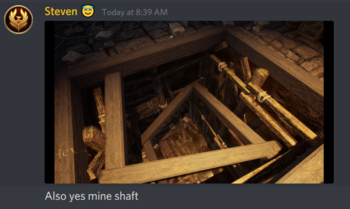
- ↑ 38.0 38.1 38.2 Transmissão ao vivo, 2022-05-27 (1:00:23).
- ↑ Unreal Engine Interview, 2017-05-23.
- ↑ 40.0 40.1 Transmissão ao vivo, 2019-12-17 (1:14:42).
- ↑ 41.0 41.1 Transmissão ao vivo, 2023-03-31 (59:10).
- ↑
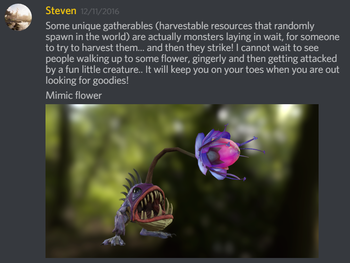
- ↑

- ↑ Transmissão ao vivo, 2017-05-19 (37:03).
- ↑ 45.0 45.1 45.2 45.3 45.4 45.5 45.6 Vídeo, 2022-10-28 (10:52).
- ↑ 46.0 46.1 46.2 46.3 46.4 Transmissão ao vivo, 2022-04-29 (25:16).
- ↑ Vídeo, 2023-06-30 (21:05).
- ↑ 48.0 48.1 48.2 48.3 48.4 Vídeo, 2022-10-28 (14:33).
- ↑ Transmissão ao vivo, 2023-05-31 (42:06).
- ↑ 50.0 50.1 Podcast, 2023-07-15 (22:57).
- ↑ Transmissão ao vivo, 2017-06-01 (24:30).
- ↑ Transmissão ao vivo, 2020-04-30 (54:33).
- ↑ 53.0 53.1 53.2 53.3 Entrevista, 2020-03-27 (9:00).
- ↑ 54.0 54.1 Entrevista, 2018-05-11 (38:25).
- ↑ 55.0 55.1

- ↑ Vídeo, 2022-10-28 (25:11).
- ↑ Transmissão ao vivo, 2022-10-14 (32:38).
- ↑ Alpha-1 screenshot.
- ↑

- ↑ 60.0 60.1 60.2 60.3 Transmissão ao vivo, 2017-05-30 (10:24).
- ↑ Podcast, 2018-05-11 (59:25).











